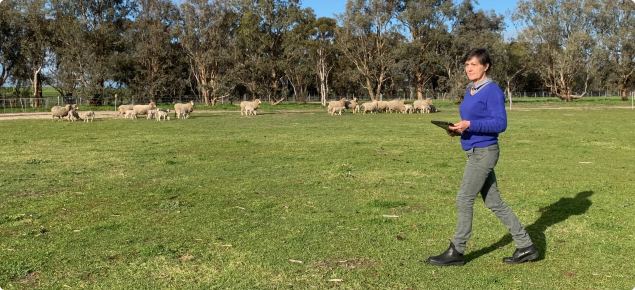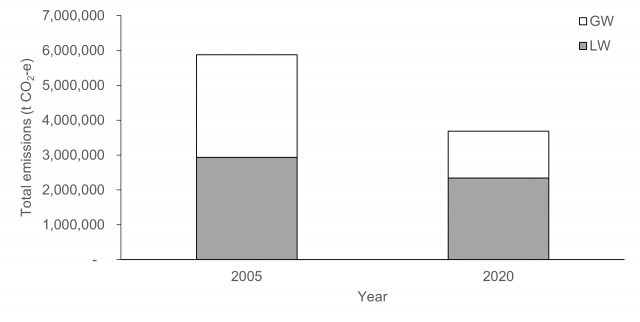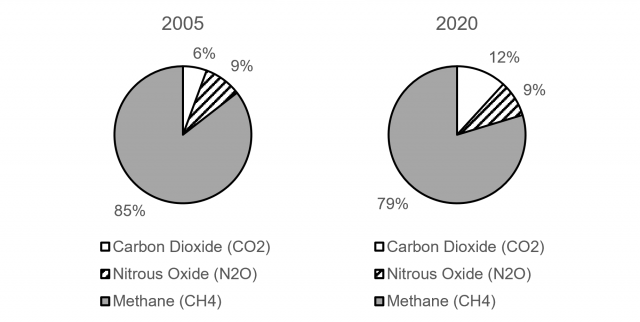An industry-wide LCA drives detailed understanding of the contributors to GHG emissions of sheep production for Western Australian. Having a clear picture of the sheep industry’s impacts on and from climate change will allow industry to make informed decisions about implementing climate-positive strategies.
The LCA provides an environmental assessment of the WA sheep supply chain to the point of turn off and can be used to benchmark performance in future years. DPIRD will examine how this assessment can be used to define, quantify, track and improve sustainability throughout the industry over time.
This nationally-significant project aligns with other DPIRD initiatives, including achieving carbon neutrality for the Katanning Research Facility (KRF).
DPIRD partnered with Integrity Ag & Environment - Australia's leading consultants in LCAs of agrifood systems with specific skills in mixed farming and sheep - to develop the analysis.
The LCA for the sheep industry covers the financial years (FY) 2005 (July 1, 2004 to June 30, 2005) and 2020 (July 1, 2019 to June 30, 2020). The analysis of one historic period provided a baseline reference point for the more recent results, and the intent was to develop an approach that could be updated into the future.
Emission estimations were determined from a detailed flock inventory for the stated years, disaggregated by region (using ABARES regions). Within each region, the flock profile was determined from sales records to meat processing, live export and eastern states. Impacts were allocated to live weight (LW) and greasy wool (GW) based on the proportion of protein in each product.
Please see the final report for more detail or the presentation slides for a summary version (see the sidebar for link) .
Results and Discussion
The study showed a 37% decrease in total emissions from 5,873,332 t CO2-e in FY 2005 to 3,681,703 t CO2-e in FY 2020 (Figure 1). The reduction in total emissions was largely due to the reduction in total flock numbers over this time. Impacts were predominantly from enteric methane (78-85%) followed by nitrous oxide (8-9%) and carbon dioxide from energy use and purchased inputs (6-13%).
The enteric methane results presented here were 9.9% and 10.1% higher than the emissions reported in the Australian National Greenhouse Gas Inventory (NGGI) for the respective years (AGEIS, 2020).
Figure 1. Total emissions (t CO2-e) for the WA sheep industry for FY 2005 and FY 2020, demonstrating the emissions attributed to liveweight (LW) and greasy wool (GW) production
Emission intensity results revealed a 10-12% increase in impacts, from 7.4 kg CO2-e kg LW-1 in FY 2005 to 8.2 kg CO2-e kg LW-1 in FY 2020. When reported for greasy wool the emission intensity increased from 24.3 kg CO2-e kg GW-1 in FY 2005 to 27.2 kg CO2-e kg GW-1 in FY 2020. These results were similar to previous case study farm analyses in WA.
The increase in emissions was unexpected. The following trends were observed that explained this outcome. Seventy two percent of the increase in emission intensity was explained by the increase in impacts from carbon dioxide, which was related to the use of purchased inputs such as diesel and fertiliser. This suggested that sheep production intensified over the period from FY 2005 to FY 2020, with higher inputs being associated with an increase stocking rates and a shift to greater meat production. Investigation into the key indicators driving this result within ABARES survey data for the years 2001 to 2020 confirmed a general trend towards increasing purchased inputs.
Figure 2. Western Australia emissions contribution analysis, FY 2005 and 2020
Changes in flock performance were also observed. Lamb marking rates and live weight turnoff per ewe increased over the comparison period, while concurrently wool yield declined. This reflected a change towards finer micron sheep with slightly lower wool yields, and a greater emphasis on meat production with higher lamb marking percentages and heavier lambs at turnoff, changing the balance between wool and meat.
Both wool and live weight are high-protein products, and to examine biological productivity we also examined total protein production (the sum of protein output in LW and GW per ewe and per DSE). This revealed no meaningful change in in protein production over this time on a dry sheep equivalent (DSE) or breeding ewe basis, showing a compensatory shift in productivity from wool to meat. Investigation into the key indicators driving flock performance and therefore change in emissions for the key years and surrounding years demonstrated little inter-annual variability, suggesting that these findings were reflective of a longer-term trend of flock performance.
Several improvement options for production in WA were explored. The purpose was to provide DPIRD with an understanding of the impacts of production improvements and assist in providing an evidence base to consider emission reduction targets.
The first option explored was the use of anti-methanogenic feed additives within the WA sheep flock. A range of scenarios were examined with different levels of adoption and different feeding strategies. The analysis showed that at maximum adoption (100% of animals supplied with additives) during the summer feed gap period (4 months of the year), reduction in enteric methane was estimated to be 11.6%, and reduction in total emissions was estimated to be 9.1%. Abatement was constrained by the efficacy of the additives, which was estimated to be 35% in a paddock feeding scenario, though this assumption was highly uncertain. Considering 100% adoption is implausible, it appears that improving the efficacy in-field will be critical to improving mitigation potential in the WA flock.
The second option explored increased flock productivity including increasing lamb marking rates, lamb-turn off weights and wool production. The most effective scenario resulted in a reduction in emission intensity to 7.7 kg CO2-e kg LW-1 and 25.5 kg CO2-e kg GW-1. This was projected by increasing lamb marking rates from 88% to 105%, lamb turnoff weights from 45 to 54 kilograms liveweight, and increasing wool production per breeding ewe from 8.6 kilograms to 9.8 kilograms.
Scenarios examining an increase in merino lamb production rather than hoggets for live export showed a very slight increase in emission intensity from this strategy, largely because additional inputs were required to achieve faster growth rates, but slaughter weights remained lower than live export.
Conclusions and Recommendations
This study provided an in-depth insight into the GHG emissions of the WA sheep industry, reporting impacts for the total flock and on an emission intensity basis, to assist DPIRD in its commitment to reducing industry greenhouse gas (GHG) emissions into the future. The project demonstrated that without deliberate initiatives to reduce impacts, current industry changes have reduced total emissions from the flock (because of flock reductions) but this has not translated into higher efficiency. Instead, intensification has resulted in higher emission intensities.
Scenario modelling showed that emission intensity could be reduced while improving flock productivity, enabling the dual outcomes of potentially better economic returns and also lower environmental impacts. However, the impacts or implications associated with changes in performance and stocking rate were not considered, which is another determinant of productivity, and this would be beneficial in future work. This study was constrained to a very small number of scenarios.
A wide range of further options will be examined in further work to explore emission reduction potential at regional scale, covering both livestock production aspects, anti-methanogenic feed supplements and land management to improve soil and vegetation carbon, which was not examined here.
Start Date: 1 April 2021
End Date: 31 December 2021



